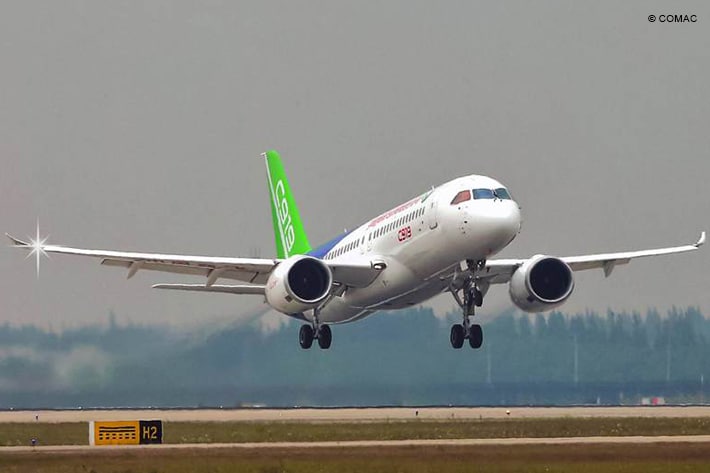Aerospace
China certifies C919 jet to compete with Airbus and Boeing
China certified its domestic C919 airplane. Pictures shared on social media demonstrated, marking a significant development in the nation’s goals to compete with Airbus (AIR.PA) and Boeing (BA.N) in the commercial aerospace sector.

On Thursday, China certified its domestic C919 airplane. Pictures shared on social media demonstrated, marking a significant development in the nation’s goals to compete with Airbus (AIR.PA) and Boeing (BA.N) in the commercial aerospace sector.
China’s Commercial Aircraft Corp. built this aircraft COMAC, being certified by the end of the month after two planes took off for Beijing on September 13 had been widely anticipated. ‘C919 airplane type certificate issuance ceremony’ was written in Chinese on a sign that was visible in one of the pictures.
COMAC C919 Successfully Completes Flight Tests(Opens in a new browser tab)
The C919, which was introduced 14 years ago and can accommodate up to 168 passengers, will face off against the well-liked Airbus A320neo and Boeing 737 MAX families in the second-largest aviation market in the world as China aims to boost its technological independence amid trade concerns.
Aircraft may built-in china heavily with western components is used, Like engines and Avionics. But China is pushing hard to inbuilt its own Engine which is in progress.
Although local media have stated that the jet is unlikely to begin commercial service with passengers until next year, the type of license awarded on Thursday allows it to be delivered to the first customer, China Eastern Airlines Corp Ltd.
Top 5 selling Narrow Body aircraft(Opens in a new browser tab)
It is unknown if the C919 will be on display or flown at the expo in November, which is the nation’s main aviation event. China will require an average of 300 narrowbody passenger aircraft like the C919 annually over the next 20 years.
Foreign Certification
In addition to the work being done by CAAC, the European Union Aviation Safety Agency (EASA) has been working for years on a certification validation process for the C919 with COMAC.
According to COMAC’s website, 28 customers have placed 815 orders for the C919 so far. But just one client, China Eastern, has made a firm delivery schedule announcement, and it anticipates only four deliveries in next year.
The Boeing 737 MAX, which has been grounded since March 2019 as a result of two catastrophic incidents, has not yet been used for commercial purposes in China.
China is also developing the wide-body Comac 929 aircraft. The C929 aircraft is being developed jointly by China and Russia, with testing possibly beginning in 2028.
The aircraft was listed in May 2022 for 653 million yuan (US$101 million), nearly matching the prices of the Airbus A320neo and Boeing 737 Max rivals and more than doubling the initial US$50 million price estimate.

Aerospace
Boeing Transfers Rocket Stage to NASA, Paving Way for Human Moon Mission

Boeing has achieved a significant milestone by providing NASA with the second core stage of the Space Launch System (SLS) rocket.
This crucial component, crafted at NASA’s Michoud Assembly Facility (MAF), is set to propel the Artemis II crew into lunar orbit, marking humanity’s return to deep space after a 50-year hiatus.
The monumental Boeing-built rocket stage, the largest element of the Artemis II mission, will embark on a journey aboard the Pegasus barge, traveling 900 miles to NASA’s Kennedy Space Center.
Comparison of two legendary aircraft B777x vs B747 aircraft:Click here
Upon arrival, it will be meticulously integrated with other essential Artemis II components, including the upper stage, solid rocket boosters, and NASA’s Orion spacecraft within the iconic Vehicle Assembly Building. This intricate integration process is a vital step toward the eagerly anticipated Artemis II launch, slated for 2025.
“Boeing-built products helped land humankind on the moon in 1969, and we’re proud to continue that legacy through the Artemis generation,” remarked Dave Dutcher, vice president and program manager for Boeing’s SLS program. “Together, with NASA and our industry partners and suppliers, we are building the world’s most capable rocket and paving the way to deep space through America’s rocket factory in New Orleans.”
NASA, Lockheed Martin Reveal X-59 Quiet Supersonic Aircraft:Click here
The delivery of Core Stage 2 marks a significant achievement in the evolution of the SLS rocket. Towering over 200 feet and powered by four RS-25 engines, this core stage, coupled with two solid-fueled booster rockets, will generate a staggering 8.8 million pounds of thrust. This immense power is crucial to launching Artemis II and future missions into the vast expanse of space.
The SLS rocket stands unparalleled in its capability to transport both crew and substantial cargo to the moon and beyond in a single launch. Its extraordinary capacity will facilitate the delivery of human-rated spacecraft, habitats, and scientific missions to destinations including the moon and Mars, ushering in a new era of space exploration.
-

 Travel1 week ago
Travel1 week agoAir India to Expand US Operations with Three New Routes After a Decade
-

 Travel2 weeks ago
Travel2 weeks agoWhy We Should Avoid These Stamps in a Passport
-

 Airlines1 month ago
Airlines1 month agoInvestigations Reveal Fake Chinese Titanium in Boeing and Airbus Jets
-

 Tech4 weeks ago
Tech4 weeks agoChina’s CATL Plans 1,800-Mile Electric Plane Launch by 2027
-

 Airport3 days ago
Airport3 days agoTop 10 Largest Airports in the World by Size
-

 Aerospace4 weeks ago
Aerospace4 weeks agoChina’s Fighter Jets Turn Wings into Autonomous Drones
-

 Airlines4 days ago
Airlines4 days agoAir India Rolls Out A350s for Delhi-New York JFK and Newark Routes
-

 Defence3 weeks ago
Defence3 weeks agoBoeing Enhances Chinook with New Engines and Block II Upgrades at $96 Million







